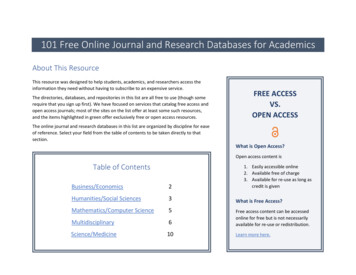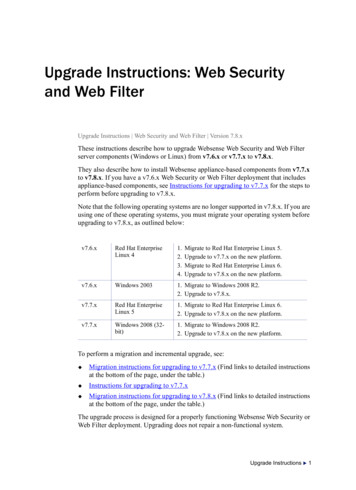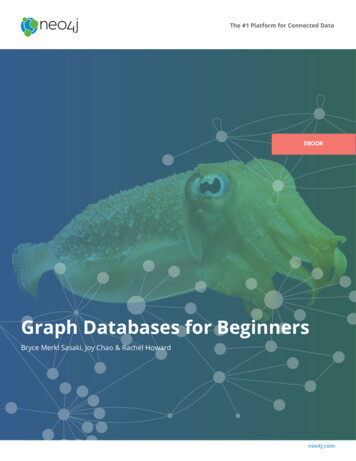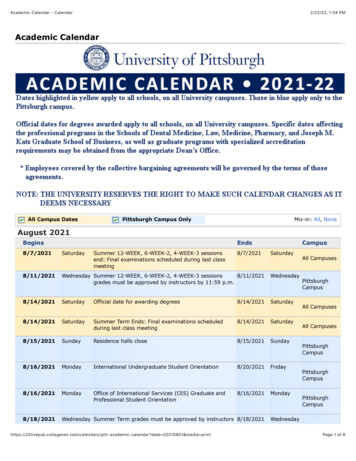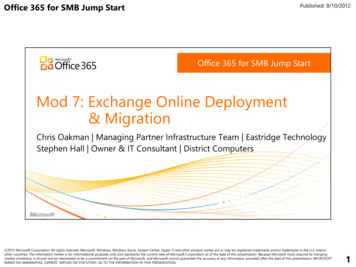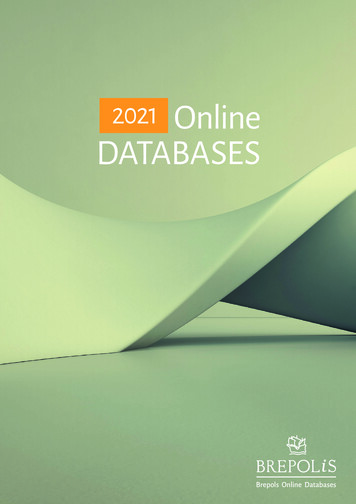
Transcription
OnlineDATABASES2021Brepols Online Databases
Table of ContentsIntroductionSource Collections2Clavis Clavium (ClaCla)Sources Chrétiennes Online (SCO)Library of Latin Texts (LLT)Monumenta Germaniae Historica (eMGH)Aristoteles Latinus Database (ALD)Archive of Celtic-Latin Literature (ACLL)Database of Latin Dictionaries (DLD)Patrologia Orientalis Database (POD)234678910Bibliographies11Bibliographie Annuelle du Moyen Âge Tardif (BAMAT)L’Année philologique (APh)International Medieval Bibliography (IMB)Bibliographie de civilisation médiévale (BCM)International Bibliography of Humanism and the Renaissance (IBHR)Index Religiosus (IR)Bibliography of British and Irish History (BBIH)11121314151617Encyclopaedias18Dictionnaire des philosophes antiques (DPhA)Lexikon des Mittelalters (LexMA)Europa Sacra (ES)Dictionnaire d’histoire et de géographie ecclésiastiques (DHGE)18191920Free-standing Databases21In Principio (INPR)Répertoire des traductions françaises des Pères de l’Église (RTF)Ut per litteras apostolicas. Papal Letters (LITPA)Vetus Latina Database (VLD)21222323Websiteswww.brepolis.net - www.brepols.netMore info on databases: https://about.brepolis.netE-NewsletterSubscribe to our free E-Newsletter: info@brepols.netPlease specify your field(s) of interest.B1
IntroductionUnequaled resources for the study ofWestern civilisation from Antiquity to thetwenty-first centuryFormore than 25 years, Brepols Publishers has beendeveloping high-value databases in the field of Humanities.Since 2001, these databases are available online on aplatform called BREPOLiS.At the moment, BREPOLiS o fers seven bibliographicdatabases, four encyclopaedias, eight full-text databasesand four free-standing databases.One of Brepols’ main fields of interest is Medieval and EarlyModern Studies. We have created an unparalleled medievalenvironment where we bring together key resources for thestudy of the Middle Ages with bibliographies on the onehand, and with encyclopaedias on the other. Two clustersare available, including “live links”:Brepolis Medieval and Early Modern Bibliographiesgathers together the International Medieval Bibliography,the Bibliographie de civilisation médiévale, and the International Bibliography of Humanism and the Renaissance.Brepolis Medieval Encyclopaedias gathers together theLexikon des Mittelalters and Europa Sacra.The other strength of Brepols lies in the study of Latinlanguage and literature as we o fer the world’s leadingdatabases in this field. Brepols has created a Latinenvironment where we bring together recent Latin textseditions and Latin dictionaries:The cluster Brepolis Latin Complete gathers together theLibrary of Latin Texts, the Monumenta Germaniae Historica,the Archive of Celtic-Latin Literature, the Aristoteles LatinusDatabase, and the Database of Latin Dictionaries. TheCross Database Searchtool allows the user to search thesedatabases simultaneously. The integration of, and easynavigation between these respective databases will befurther enhanced over the coming years.A last cluster of databases is dedicated to Religious Studiesand Church History and includes the Index Religiosus, theDictionnaire d’histoire et de géographie ecclésiastiques, andthe Bishops of the Holy Roman Empire (Bischöfe des HeiligenRömischen Reiches).Not content with having developed such tools, we are stillworking to further improve these databases and to makenew tools available to the international community ofscholars. The four most recent databases are Clavis Clavium,Sources Chrétiennes Online, the Bibliographie annuelle du moyenâge tardif, and the Dictionnaire des philosophes antiques.Brepols Online Databases1
Launched in 2020Clavis Clavium (ClaCla)The Gateway to Late Antique and Medieval LiteratureAvailable in Open AccessClavis Clavium, or ‘Key of Keys’, is the go-todatabase to access Late Antique and MedievalChristian literature. It incorporates the almost8,000 pages of data found in six so-calledclaves: the Clavis Patrum Latinorum andthe Bibliotheca Hagiographica Latina, theClavis Patrum Graecorum and the BibliothecaHagiographica Graeca, the Clavis ApocryphorumVeteris Testamenti and the Clavis ApocryphorumNovi Testamenti. Together, these six indispensable tools provide researchers working on theextensive field of Early Christian, Medieval andByzantine literature with essential informationregarding authorship, authenticity, chronological and geographical contexts, manuscripttransmission, and editorial history.Now, with the creation of the Clavis Clavium database, researchers can for the first time access thisenormous mass of printed data in an integratedand accessible way. The database allows all sixclaves to be searched together, for maximume ficiency, and it o fers huge versatility throughsearch options that can combine di ferent categories (e.g. title, incipit, desinit, author, or saint).Continuously updated (a ter peer review) withmaterial brought together by specialists in thefield, the Clavis Clavium is a dynamic researchtool that will continue to be expanded and updated in the future as new claves and materialare added, and by serving as a gateway to other(third-party) information and functionalities.Essential Research ToolThe Clavis Clavium is an essential research toolfor historians, theologians, philologists, andphilosophers.Related Databases The database is an essential gateway to otherfull-text databases available on BREPOLiS, suchas Library of Latin Texts or Sources ChrétiennesOnline.2Source CollectionsKey Features Presents the mass of printed datain an integrated and accessibleway: no more comparing di ferentclaves to gather all availableinformation about one and thesame text or author Continuously updated: no more waitsfor a new printed update. ClaCla iscontinuously updated – not, as in thepast, by one or two scholars, but by ahost of specialists, whose contributionsare subjected to peer review Versatile: you pick the way youwant to access the data (via title,incipit, desinit, author, saint, or via a combination of twoor more of these categories) Ever-expanding: the list of claves weplan to add in the future is long, e.g.Clavis Patristica PseudepigraphorumMedii Aevi, Théologie Byzantine,Traditio Patrum,
OURC ESCHRÉTIENNESSLaunched in 2020ONLINEFromits inception in 1942, the “SourcesChrétiennes” series (based in Lyon andpublished by Éditions du Cerf in Paris) hasprovided critical editions of texts from the first1,400 years of the Church, accompanied bya French translation as well as an introductionand notes. More precisely, the series consists ofeditions-with-translations of Christian texts inGreek and Latin, but also in oriental languages,such as Syriac, Armenian and Georgian. Whereasit has always been the series’ mission to makethe texts at hand easily accessible for consultation and (linguistic, historical, philosophicaland theological) study, Sources ChrétiennesOnline even expands the possibilities in thisregard. Reserving the introduction, apparatusand notes for the printed series, the onlinedatabase makes it possible to select textsalong various criteria and to perform targetedsearches both on the source texts and on theFrench translations that over the years havebeen published in the series.Sources ChrétiennesOnline (SCO)Critical texts and French translations that havebeen published in the printed “Sources Chrétiennes”series now available in a searchable databaseKey Features Online version of theSources Chrétiennes series Both the source texts andthe translations are searchable Texts in Greek, Latin, Syriac,Armenian and Georgian Multiple filters allow fortargeted searches French translations Quick suggestions of translation(based on Lewis & Short) andmorphological analysis forLatin words, thanks to theInstrumenta tool 200 volumes available at launch 100 volumes added per year(all volumes available in 2025) 4 updates per yearRelated Databases For patristic texts see also the full-text databases Library of Latin Texts and PatrologiaOrientalis Database.Source Collections3
Library of Latin Texts (LLT)The world’s leading database for the studyof Latin textsThe project was started in 1991 as the Cetedoc Library of Christian LatinTexts, CLCLT, under the direction of Prof. Paul Tombeur. From 2009 onwards, the database is known as the Library of Latin Texts, the world’sleading database for Latin texts.The new name Library of Latin Texts refers to the expansion of thechronological limits that were originally set, as well as to the broadening of its horizon which now integrates the initial Christian outlookinto a general cultural perspective. The aim now is to o fer a databasethat continues to expand and aims to comprise not only Latin literaturefrom the patristic and medieval periods but also from Antiquity and theearly-modern and modern eras. The Library of Latin Texts gathers Latintexts of all genres and all periods. Great importance is attached totranslations, essentially from Greek originals, into Latin.Literature from AntiquityThe first chronological part of the database comprisesthe entire corpus of Latin literature from ClassicalAntiquity up to the second century AD.(opera omnia of Plautus, Terence, Caesar, Cicero, Virgil, Horace,Ovid, Titus Livius, the Senecas, the two Plinys, Tacitus,Quintilian and the others). The texts from this sectioncome essentially from the Bibliotheca scriptorum RomanorumTeubneriana / Bibliotheca Teubneriana Latina 1 ( Walter deGruyter).With regard to this corpus, the objective of the database can be summarised in the brief sentence: “Who said what, when, where, and howmany times?”Literature from Patristic AuthorsThe textual material integrated into the database forms the first ofthe two pillars on which the Library of Latin Texts is built, the other onebeing a rich pool of sophisticated search tools.The second chronological part of the database comprises the patristic Latin literature that starts around200 A.D. with Tertullian and ends with the death ofthe Venerable Bede in 735.The LLT is the reference database for Latin texts, o fering texts from thebeginnings of Latin literature down to the present day.In total, the present version of the LLT contains more than 130 millionLatin words, drawn from more than 11,000 works (including 5,800 diplomatic charters) that are attributed to approximately 1,950 authors.The texts are selected from the best editions available and when possible established according to best contemporary scholarly practice. Greate forts have been undertaken to verify facts relating to the text, such asthe veracity of the authorial attribution or the dating. The printed texthas o ten been enhanced by correcting detected typographical errors.In order to isolate, as far as possible, the words proper to each work, adistinction is made between the original text and the “paratextual”elements.4ContentSource CollectionsIt o fers the complete works of important patristic writerssuch as Ambrose, Augustine, Ausonius, Cassian, Cyprian,Magnus Felix Ennodius, Gregory the Great, Jerome, MariusVictorinus, Novatian, Paulinus of Nola, Prudentius, Rufinusof Aquileia, Salvian, Tertullian, Victor of Vita, the Latintranslations of the Apostolic Fathers, and many rich corporaof authors such as Boethius, Cassiodorus, Eucherius of Lyon,Gennadius of Massilia, Hilary of Poitiers, Ildefonus of Toledo,Isidore, and Bede. It also contains non-Christian literatureof that period, by authors such as Ammianus Marcellinus,Claudian, Macrobius, Martianus Capella, or the ScriptoresHistoriae Augustae. This second part also contains the complete critical text of the Latin Bible according to the Vulgate,the corpus of Latin Pseudepigrapha of the Old Testament,and the Decrees of the Ecumenical Councils of Late Antiquity.
Literature from the Middle Ages (736-1500)The medieval literature in the database comprises Latinliterature a ter 735 and includes a large number of textsup to 1500.This part of the database contains more than 83 million wordsand continues to develop. It includes the complete works ofmany medieval authors such as Anselm of Canterbury, Beatusof Liebana, Bernard of Clairvaux, Rupert of Deutz, SeduliusScottus, Thomas Aquinas, Thomas a Kempis, Thomas ofCelano or William of St. Thierry. It also includes the Sentencesand the Commentaries on the Pauline epistles of PeterLombard, the Rationale of Guillaume Durand and importantworks by Abelard, Bonaventure, Hildegard of Bingen, Hughof Saint Victor, Jan Hus, Ramon Llull, William of Ockham,Walter of Châtillon’s Alexandreis, an important collection ofhagiographical texts and of liturgical works, a huge corpus ofworks related to the beginnings of the Franciscan order, andmany others.Key Features Contains more than 5,300 texts Academic partner: Centre ‘Traditio LitterarumOccidentalium’ Updated yearly with new material Interface in English, French, German and Italian The powerful search-so tware enables the usersto undertake enhanced search possibilities: by using wildcards and Booleans operators,the user can construct complex searchqueries filters are used when, instead of searchingthrough the entire data set, one wishes torestrict the search to a particular Authoror group of Authors, a particular Work, aparticular Period or CenturyNeo-Latin Literature (1501-1965)This part of the database already contains almost 12million words and continues to develop.It includes, for instance, the decrees from the modernecumenical Church councils up to Vatican II, the Latintranslations of John of Ruusbroec made by the GermanCarthusian Laurentius Surius, important Latin works ofRené Descartes, Lipsius’ De constantia, the Christianae religionis institutio of Calvin (according to the edition of 1559),poetical works by Joachim du Bellay and by the Jesuit JacobBalde, the epic Colombus poem of Ubertino Carrara SJ, thecomplete works of Lawrence of Brindisi, and many others.Recently Added TextsErasmus’ Correspondence,Spinoza’s main works,Martin Luther’s Ninety-five Theses and various other works,Peter Abelard’s Logica and various other works,Francis Bacon’s Novum organum,Meister Eckhart’s Commentary on John and various other works,Denis the Carthusian’s Commentary on the Psalms,the recently published Sermons of Augustine,etc.Related Databases The interface is the same as Brepols full-text databases (Monumenta Germaniae Historica, Archive ofCeltic-Latin Literature and Aristoteles Latinus Database). Links to the Database of Latin Dictionaries (a user canselect a word found in a text of LLT and automatically find entries on the word in the constituentdictionaries of the Database of Latin Dictionaries); theconnection between LLT and the Database of LatinDictionaries will be enhanced over the coming years. By using the Cross Database Searchtool, LLT can besearched online together with the MonumentaGermaniae Historica, the Archive of Celtic-LatinLiterature and the Aristoteles Latinus Database. The cluster Brepolis Latin Complete includes all Latinfull-text databases and dictionaries.Source Collections5
Monumenta GermaniaeHistorica (eMGH)The online counterpart of one of the most prestigiouseditorial undertakings for the critical publication ofmedieval historical textsThe Monumenta Germaniae Historica wasfounded in 1819 by the Gesellscha t für Deutschlandsältere Geschichtskunde. It is without doubt one ofthe most prestigious editorial undertakings forthe critical publication of medieval historical texts.In more than 300 volumes, covering the widest possible range of historical documents,divided into five major Series (Scriptores, Leges,Diplomata, Epistolae and Antiquitates) and into33 Subseries, the Monumenta not only continues its editorial programme but it has established for all Western scholarship a standardfor critical editions.The powerful search engine developed by theCentre ‘Traditio Litterarum Occidentalium’and Brepols Publishers allows unparalleled exploitation of this important body of texts, permitting in-depth searches of the corpus.Related Databases The integration of the eMGH into the BrepolisLatin platform o fers the opportunity to carryout searches simultaneously with other collections of texts bringing together a total of almost 10,000 works (eMGH, Library of Latin Texts,Aristoteles Latinus Database, Archive of Celtic-LatinLiterature), and allows the user to search Latinreference dictionaries (Database of Latin Dictionaries). The cluster Brepolis Latin Complete includes allLatin full-text databases and dictionaries.6Source CollectionsKey Features The eMGH contains morethan 3,700 texts Interface in English, French,German and Italian In updates, precedence is generallygiven to narrative sources Advanced search capacities forthe eMGH are combined withthe possibility of accessing thedigital version of each text.Thus, from each search result, alink to the digital version of thecorresponding page (along withits critical apparatus) is o fered The powerful search-so twareenables the users to undertakeenhanced search possibilities: by using wildcards and operators,the user can construct complexsearch queries filters are used when, insteadof searching through the entiredata set, one wishes to restrictthe search to a particular Authoror group of Authors, a particularWork, a particular Period orCentury
Aristoteles LatinusDatabase (ALD)The complete corpus of medieval translationsof the works of AristotleThe critical edition of the Medieval LatinAristotle is one of the main projects supervisedand supported by the Union Académique Internationale / International Union of Academies.The most important objective of the project isto bring to scholarly attention the various formsin which Aristotle’s texts came to be read in theWest. The Latin versions of these texts constituted the main tools for the study of scienceand philosophy in the Middle Ages. They wereconsidered as being the canonized littera towhich all the commentaries on Aristotle’s worksreferred. The role played by these translations inthe development of the Western philosophicaland scientific terminology can thus hardly beoverestimated. All the texts that have been critically edited in the series Aristoteles Latinus arenow available online together with the texts notyet available in a critical edition.Key Features Academic partners: InternationalUnion of Academies, AristotelesLatinus Centre (KatholiekeUniversiteit Leuven) andCentre ‘Traditio LitterarumOccidentalium’ The texts constitute the maintools for the study of science andphilosophy in the Middle Ages Interface in English, French,German and Italian The powerful search-so twareenables the users to undertakeenhanced search possibilities: by using wildcards and Booleansoperators, the user can constructcomplex search queries filters are used when, insteadof searching through the entiredata set, one wishes to restrictthe search to a particular Authoror group of Authors, a particularWork, a particular Period orCenturyRelated Databases The interface is the same as for the otherBrepols full-text databases (Library of LatinTexts, Monumenta Germaniae Historica andArchive of Celtic-Latin Literature) and the CrossDatabase Search Tool allows the user to searchall of these databases together. Live links to the Database of Latin Dictionaries:a user can select a word found in a text of ALDand automatically find entries on the word inthe constituent dictionaries of the Database ofLatin Dictionaries. The cluster Brepolis Latin Complete includes allLatin full-text databases and dictionaries.Source Collections7
Archive of Celtic-LatinLiterature (ACLL)The corpus of Latin literature produced inCeltic-speaking Europe from the period 400-1200 ADIn the early Middle Ages, literate individuals in and from the Celtic periphery of Europe(Ireland, Wales, Brittany, Cornwall, Scotland andthe Isle of Man) wrote many and varied Latinworks constituting what can arguably be seenas a distinctive literature, whose unusual vocabulary, grammar and phrasing (to say nothingof subject-matter) made it into what has beencalled “one of the most curious and interestingphenomena of medieval philology”.Subject AreasThis database contains more than five hundred Latin works by over a hundred knownand unknown authors, spanning the fieldsof theology, liturgy, computistics, grammar,hagiography, poetry and historiography, andincluding legal texts, charters, inscriptions, etc.Related Databases The interface is the same as the one for otherBrepols full-text databases (Library of LatinTexts, Monumenta Germaniae Historica andAristoteles Latinus Database) and the CrossDatabase Search Tool allows the user to searchall of these databases together. Live links to the Database of Latin Dictionaries: auser can select a word found in a text of ACLLand automatically find entries on the word inthe constituent dictionaries of the Database ofLatin Dictionaries. The cluster Brepolis Latin Complete includes allLatin full-text databases and dictionaries.8Source CollectionsKey Features Contains more than 500 texts Academic partners: Royal IrishAcademy and Centre ‘TraditioLitterarum Occidentalium’ Interface in English, French,German and Italian Possibility to find a text basedon a Lapidge & Sharpereference (L&S) The powerful search-so twareenables the users to undertakeenhanced search possibilities: by using wildcards andBoolean operators, the usercan construct complexsearch queries filters are used when, insteadof searching through theentire data set, one wishesto restrict the search to aparticular Author or groupof Authors, a particular Work,a particular Period or Century
Database ofLatin Dictionaries (DLD)An unparalleled resource for research onthe Latin language throughout the agesBecause of its broad spectrum of dictionaries,the Database of Latin Dictionaries (DLD) o fers animmediate overview of Latin vocabulary that noisolated dictionary can give.In order to cover all possible perspectives onLatin vocabulary, the DLD o fers several kindsof dictionaries: defining and translating, thematic, medieval and early modern. Therefore,the DLD is a major tool both for students learning Latin and for experienced scholars.Key Features 24 Dictionaries available Academic responsibility:Centre ‘Traditio LitterarumOccidentalium’ Multilingual interface (English,French, German and Italian)The interface provides first-time users witha simple search option, while the more experienced can explore the advanced searchpossibilities where all kinds of words or expressions, Latin or Non-Latin, can be the object ofcomplex queries using various criteria, singlyor in combination. Defining, translating, thematic,medieval and early moderndictionariesStarting in 2005 with only two dictionaries,it has now grown into a large collection of 24dictionaries. Each year at least one dictionaryis added and various improvements are madeto the existing ones. These improvements canbe corrections to the original text, increasedsearch possibilities or the addition of newlypublished addenda. The DLD strives to give itsusers the best and most up-to-date information. Newly added: Meyer-Lübke, W.(1935), Romanisches etymologischesWörterbuch, Heidelberg: Winter Search by Latin dictionaryheadwords or by non-Latin words(English, French, Spanish, Italianor German) The DLD includes the Dictionary ofMedieval Latin from British Sources(DMLBS) The DMLBS provides online accessto the complete printed version( The British Academy, finalfascicule published in December 2013) The database presents thevocabulary of the Latin languageas written in Britain and by Britonsabroad from Gildas (AD 540) toCamden (1600)Related Databases The DLD provides links to the full-text databases(Library of Latin Texts, Monumenta GermaniaeHistorica, Aristoteles Latinus Database and Archiveof Celtic-Latin Literature). The cluster Brepolis Latin Complete includes allLatin full-text databases and dictionaries.Source Collections9
Patrologia OrientalisDatabase (POD)The corpus of patristic texts from the Christian Eastpublished in the Patrologia Orientalis seriesThe Patrologia Orientalis Database (POD) is acollection of patristic texts from the ChristianEast, including works, recorded in non-Latin languages, that come from geographical, cultural,or religious contexts somehow linked to Romeor the Eastern Roman Empire.This initial version of the database allows usersto access texts included in the Patrologia Orientalis (PO) series in two forms: the original text,available as a PDF file, and a searchable translation. The user can search for items (such as keywords or quotes) in the language into which atext was translated in the PO. All the texts in thePO are searchable, and the reader can check thetranslation with the original text visible alongside as a non-searchable PDF file.Related Databases For patristic texts see also Library of LatinTexts (full-text database), Sources ChrétiennesOnline (full-text database including Frenchtranslation), and Répertoire des traductionsfrançaises des Pères de l’Eglise (repertorium).10Source CollectionsKey Features Provides the online version oftexts and translations publishedin the Patrologia Orientalis series Each text is provided in its originallanguage (Syriac, Armenian,Arabic, Coptic, Ge’ez, Georgian,and Slavonic) and in translation Translations are searchable Numerous filters (author, title,subject, language, etc.) Multilingual interface (English,French, German, and Italian) Content up-to-date with printedseries by the end of 2020
Launched in 2020Bibliographie Annuelle duMoyen Âge Tardif (BAMAT)OnlineThe Annual Bibliography of Late MedievalLatin Authors and TextsThis database, published in collaboration withthe IRHT, forms an answer to the challenge raisedby the proliferation of the current bibliography,by focusing on two criteria: the speed of thedata extraction and the analytical quality of therecords.The database provides an up-to-date bibliography with very little timelag. It is a bibliographyabout late medieval authors and texts, andincludes the manuscripts cited in catalogues bylibrary collections, by genres, or by authors aswell as in editions or other studies.Key Features Online version of the BibliographieAnnuelle du Moyen Âge Tardif(Brepols Publishers, 1992-) More than 115,000 bibliographicrecords More than 10,000 historicalauthors, over 48,000 manuscriptsand 60,000 incipits Direct links with In Principio Annual updates Partner: the Institut de Rechercheet d’Histoire des Textes (Paris) Numerous search fieldsRelated Databases For other medieval and early modern bibliographies, see the International MedievalBibliography (IMB), the Bibliographie de civilisation médiévale (BCM), and the InternationalBibliography of Humanism and the Renaissance(IBHR). Another useful research tool for the study ofthe writers, texts and manuscripts of Antiquity,the Middle Ages, and the Renaissance isIn Principio, the incipit index of Latin texts. For the study of Latin texts, see also the fulltext database Library of Latin Texts.Bibliographies11
L’Année philologique (APh)The reference bibliography for academic publicationsrelating to Ancient Greek and Roman CivilizationL’Année philologique, published by the Société In-ternationale de Bibliographie Classique, is a specialized bibliographic database of scholarly worksrelating to all aspects of Ancient Greek andRoman civilizations. The bibliography is published in print and online. The online databaseincludes all volumes of the annual index, beginning with Volume I published in 1928. Both theonline and print publications are now availablevia Brepols Publishers.Key Features Broad coverage of publicationsrelated to Antiquity, includingLate Antiquity More than 868,000 bibliographicrecords and 519,000 review references About 14,000 records addedannuallySubject AreasL’Année philologique covers a wide array ofsubjects, including Greek and Latin literatureand linguistics—which includes early Christian texts and patristics—Greek and Romanhistory, art, archaeology, philosophy, religion, mythology, music, science, and scholarly subspecialties such as numismatics, papyrology, and epigraphy.Abstracts of journal articles are provided inEnglish, German, Spanish, French, or Italian.Book entries may include tables of contents andbook review information.Related Databases Live links to ancient authors and texts in theLibrary of Latin Texts published by Brepols andto external full-text resources on the ClassicalWorks Knowledge Base , including PHI ClassicalTexts, Perseus Digital Library and ThesaurusLinguae Graecae.12Bibliographies More than 1,000 journalsindexed Records include abstracts forarticles, citations of reviewsfor monographs, and tables ofcontents for edited volumes Multiple search fields: author, title,year of publication, subject, etc. DOI links to the full text ofa book or article Several export formats(EndNote, Zotero, RefWorks,Microso t O fice Word) Multilingual interface Metrics component that enablesusers to examine in detail trendsin Classics, see journal profiles(e.g. information on subjectsand periods covered), and findauthors’ publication profiles Compatible with OpenURL,facilitating linkage to full text Email alerts
International MedievalBibliography (IMB)Multidisciplinary Bibliography of Europe,North Africa and the Near East (300-1500)The International Medieval Bibliography wasfounded in 1967 with the support of the MedievalAcademy of America, with the aim of providing acomprehensive, current bibliography of articlesin journals and miscellany volumes (conferenceproceedings, essay collections or Festschri ten)worldwide. Its editorial sta f is based at theInstitute for Medieval Studies at the Universityof Leeds, and the project is supported by over 50teams of contributors in Europe, North America,Australia and Japan.The International Medieval Bibliography comprisesmore than 500,000 articles, all of whic
4 T he project was started in 1991 as the Cetedoc Library of Christian Latin Texts, CLCLT, under the direction of Prof. Paul Tombeur.From 2009 on-wards, the database is known as the Library of Latin Texts, the world’s leading database for Latin texts. The new name Library of Latin Texts refers to the expansion of the chronological
